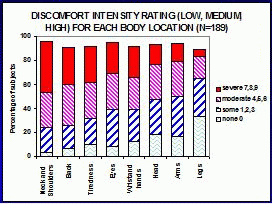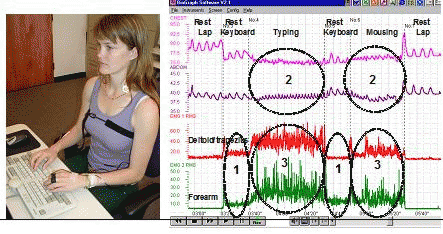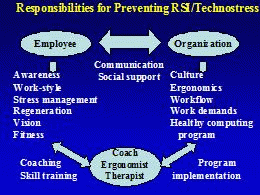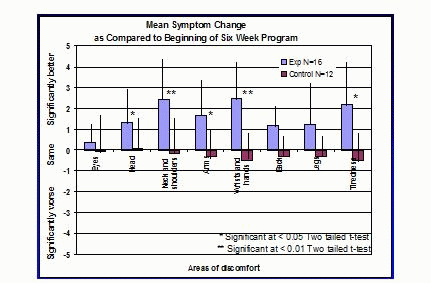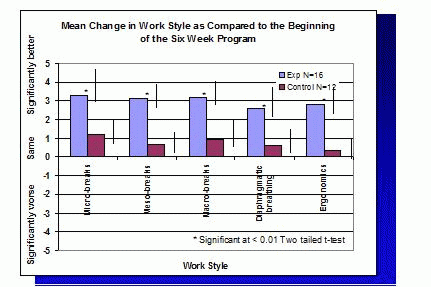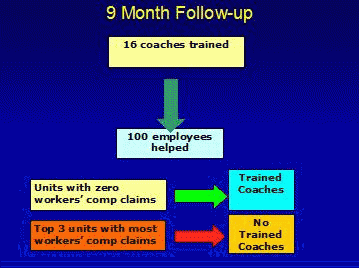| Back Futurehealth | |||||||
|
Original Content at https://www.futurehealth.org/articles/From-Technostress-to-Techn-by-Erik-Peper-081114-333.html |
|||||||
November 14, 2008
From Technostress to Technohealth
By Erik Peper
work stress, caused by long hours, sitting at computer stations, causes pain and worst-- technostress-- even with ergonomic interventions. This program added coaching and self regulation biofeedback training to produce enhanced health-- technohealth.
::::::::
Erik Peper, Ph.D. and Richard Harvey, Ph.D
San Francisco State University
"The total yearly costs of neck and upper extremity pain in the Netherlands (population of 16.4 million) due to decreased productivity, sick leave, chronic disability for work and medical costs were recently estimated at 2.1 billion euros (Blatter et al, 2006)."
----Maaike A. Huysmans (2008)
People, especially young adults, are spending increasingly more and more time connected to their computer (Subrahmanyam, Kraut, Greenfield & Gross, 2000). At school or home they send emails, chat and surf the net, and sit behind the computer eight hours a day at work. Even when going on vacation, they stay connected to the internet through their "Blackberry" or the Wi-Fi connections at hotels and coffee shops. Employees are often on call 24/7 (twenty four hours a day, seven days a week) 365 days a year. The combination of intensive computer use and work demands has resulted in an increase (epidemic) of illness (Kalia, 2002). For example, more than 30% of employees who work at the computer experience neck and back pain; hand and arm pain, tingling and numbness; and exhaustion ( Chauhan, 2003) . The European Agency for Safety and Health at Work (2004) has reported that more than a third of European workers complained of back-ache. The largest increase in back-ache are seen among computing professionals and technicians. More than 25% of European experience work-related neck-shoulder pain and 15% experience work-related arm pain (De Kraker and Blatter, 2005). This report suggests that the complaints are most prevalent among people who spent more time on the computer and work continuously without breaks. Beside professionals, college students (average age 25 years old) also report significant discomfort while working at the computer during the periods of high stress (e.g. the later part of the semester when papers and exams are due) as shown in figure 1 (Peper & Gibney, 1999).
Fig 1. Distribution of discomfort for different body areas. Categories high, medium, low are derived from the responses on the self-rating discomfort scale (0=none to 9=extreme).
In Japan, "Karoshi", death from overwork, accounted for more than 5,000 suicides in 2006 (Hida, 2008). Furthermore, Japan had the highest proportion of people working more than 50 hours per week, with 28.1 % as compared to less than 10% of employees working more than 50 hours per week in most EU countries (Hida, 2008). Another alarming statistic described by Hida (2008) is that the ratio of employee use of paid vacations dropped to 47 percent in 2004 from 61 percent in 1980. This paper suggests that overwork without opportunity for regeneration or repair places people at significant risk for experiencing technostress (Burke, 2008).
Physiological factors that contribute to technostress
Technostress contributes to increasing discomfort and illness at the worksite, especially for those who work at the computer, and can be labeled as "stress immobility syndrome" (Peper & Weijman, 2003; Scaer, 2001). This syndrome occurs when someone works for many hours while stressed, stationary and functionally immobilized with little awareness that this contributes to illness. This paper offers a solution for transforming "technostress' into "technohealth' with the broad goal of reducing illness and improving health and productivity. For example, the most common intervention begins with ergonomic changes so that the person may work in less physically stressful positions. In the case of ergonomics approaches, the correct arrangement for performing the necessary work may include adjusting or changing the chair, keyboard, desk, monitor, as well as light, sound, and all other environmental factors. Even the arrangement of mouse is critical as the mouse use affects arm and shoulder muscle tension. For example, Harvey and Peper (1997) showed that when the pointing device (mouse or trackpad) is located centrally instead of next to the computer keyboard the upper trapezius and anterior deltoid electromyography activity is significantly reduced. Nevertheless, even with the best ergonomic position, illness may still occur, as described in the following vignette (Peper & Gibney, 2007, p. 27).
"Two years after his first ergonomic assessment Mark was still suffering. His employer had followed the recommendations of the ergonomist, purchasing a new chair and keyboard, lowering the monitor, and installing an adjustable workstation with a slant table. Yet, with all these changes, Mark continued to complain of severe and chronic neck pain, tingling down his arms, and aching in his forearm. In fact, his discomfort had increased."
Mark's story is, unfortunately, a very common one. Why, after spending so much money and making the ergonomic corrections, would Mark as well as thousands of other workers still suffer from computer-related disorders? The answer is that technohealth is more than optimizing computer workstation ergonomics. Computer-related injuries tend to occur when employees are captured by their work, engrossed, fixated by the demands of their tasks, and are unaware of, or ignore, physical discomfort, pain or other hurts. For example, in a study by Peper, et al, (2003) almost all employees studied thought that their muscles were relaxed when they were sitting correctly at the computer. However, the actual physiological data showed a different picture. Even while pausing with hands resting on the wrist rest, they did not totally relax their arms and shoulders as shown in Figure 2.
Figure 2 is a representative recording of a person working at the computer. Note the following: 1) forearm and shoulder (deltoid/trapezius) muscle tension increased as the person rests her hands on the keyboard without typing; 2) respiration rate increased during typing and mousing; 3) shoulder muscle tension increased during typing and mousing; and, 4) there were no rest periods in the shoulder muscles as long as the fingers are either resting, typing, or mousing.
Employees working at the computer tend to be unaware of holding chronic, unnecessary muscle tension. Peper et al, (2003) found that 95% of the participants automatically tensed (raised) their shoulders as well as maintained low-level of tension in
their forearms while keyboarding and mousing. Sustaining a posture of tension--raised shoulders, arms reaching forward, rapid shallow breathing, and, sometimes, colder fingers--inhibits the body from relaxation and places the employee at risk of injury. This increased arousal maintains a catabolic/ergothrophic state in which regeneration is constrained. Only when a person relaxes and feels safe does muscle tension decrease and breathing slows. Both psychological as well as physical relaxation promotes the anabolic/trophotropic state during which psychological and physical regeneration may occur (Nixon, 1989).
Both psychological and physical regeneration facilitate technohealth. For example, consider your own patterns of computer equipment use when you wait in anticipation, with your arm extended, finger lifted and ready to click the mouse button. Ask yourself how often while waiting in anticipation does your breathing become more shallow and rapid? Lack of somatic awareness during computer use is a major contributing factor to the development of work-related discomfort. Shumay & Peper (1995) have shown that when working at the keyboard subjects were unaware of their shoulder muscle tension as indicated by a low. (20-25%) correlation between the subjective rating of tension and actual surface electromyographic muscle activity recorded from their trapezius and deltoid muscles. A more important point relevant for understanding technostress was that almost all participants studied thought that their muscles were relaxed when they were sitting correctly at the computer, even though they were tense (Peper et al 2006). Whereas ergonomic changes are necessary, they are insufficient for transforming technostress into technohealth. Employees need to change their somatic patterns and workstyle to reduce stress and enhance health.
From technostress to technohealth: A training protocol
After implementing a six-session training intervention at the worksite which incorporated biofeedback, Peper et al (2004) demonstrated that employees report significant improvement in their health. The detailed training protocol and methodology has been described in the book, Muscle Biofeedback at the Computer, by Peper and Gibney, 2006. This technohealth intervention is rooted in a systems perspective, where preventing technostress and the specific symptoms associated with repetitive strain injury (RSI) results from a collaboration between the employee, managers and the corporation. The many components that contribute to shifting technostress to technohealth are illustrated in Figure 3.
Figure 3. The multiple factors that contribute to the prevention of repetitive strain injury and technostress. The responsibilities are shared with both the employee and the employer.
The technohealth training intervention consisted of six weekly, two-hour group sessions consisting of an educational component as well as practice of muscle tension awareness and control as measured by surface electromyography (SEMG) (see Table 1 for detailed outline of group training sessions). The practice component included using SEMG measurements for demonstrating increased tension during data entry and, for practicing slow diaphragmatic breathing during computer work. Additionally, participants learned how to use SEMG feedback of muscle tension during on-going activities at their workstations. Participants practiced both at home and at the worksite with portable SEMG equipment, focusing on: 1) raising awareness of shoulder tension while typing or mousing; 2) improving the ability to relax forearms by increasing the duration of micro-breaks; and, 3) noticing the effect of various body positions and ergonomic postures on subsequent SEMG activity (Peper & Gibney, 2000).
The educational component was labeled Healthy Computing and provided a general overview of technohealth concepts that included: somatic awareness, stress management, psycho-social support, ergonomic principles, work style, vision care, regeneration, and strength and flexibility training. In addition, the intervention provided group support as well as supervision in learning to apply these skills personally or with others.
Participants in the technohealth intervention were responsible for keeping logs of shorter or longer duration breaks while working at the computer, which they identified as micro-, meso-, and macro-breaks. An example of a micro-break was dropping one's hands on the lap and reducing forearm muscle tension for one or two seconds. An example of a meso-break was stopping to stretch the arms or even the total body for five to 20 seconds. A macro-break was taking time out to move the whole body such as going for a walk for several minutes. Trainees were also encouraged to augment their awareness by installing on their computer an "interrupt program' designed for alerting the users to take breaks at set intervals. Finally, each participant was asked to transfer what they had
learned to other by coaching other co-workers on the best methods for utilizing the knowledge and skills gained from the program as well as using the portable SEMG biofeedback equipment for directly monitoring excessive muscle tension while computing. All participants verbally reported during the group training sessions that they had increased the frequency of taking breaks, practicing with SEMG biofeedback equipment and, teaching others what they had learned.
At the conclusion of the study, the Technohealth Experimental and Control Group subjects were each mailed or emailed post-intervention rating forms. The forms included a work-related symptom and work style questionnaire in which they rated their self-report changes as compared to the beginning of the training. Completed post-intervention forms provided the data for comparing intervention effectiveness. For example, employees from departments without co-workers who participated in the program had increased numbers of worker's compensation injury claims. More evidence of the technohealth intervention impact is presented in greater detail in the results section below.
Table 1: Syllabus of Six Week Coaches Training Program
Session 1
" Introduction and presentation of the components that underlie Healthy Computing (Peper & Gibney, 2000).
" Demonstration using multimodal biofeedback of physiological response patterns that occur during typing and mousing with emphasis on: lack of awareness, muscle bracing of the deltoid and trapezius, absence of micro-breaks, emotional reactivity with electrodermal activity and respiration pattern changes (Peper et al, 2003).
" Demonstration and training with a Myotrac - , single-channel portable electromyography (EMG), for monitoring from the deltoid, trapezius, and forearm muscles.
" Brief discussion of micro-, meso- and macro breaks.
" Assignment of homework practices that included taking micro-, meso- and macro-breaks; EMG practice; and assigned reading from Muscle Biofeedback at the Computer: A Manual to Prevent Repetitive Strain Injury (RSI) by Taking the Guesswork out of Assessment, Monitoring and Training (Peper and Gibney, 2006).
" Recommendation to download and install a break reminder computer program.
Session 2
" Group discussion of previous week's home practices. Guidelines on how to work with other people, transferring what was learned to others.
" Demonstration and practice of micro-, meso-, macro-breaks and the importance of interrupt programs.
" EMG feedback practice for micro-break training and how to optimize ergonomic positions.
" Presentation of ergonomic guidelines and factors
" Assignment of homework practices that included practicing breaks, typing with relaxed shoulders, using the EMG personally and with co-workers, assessing personal workstation using the ergonomic check list, and assigned reading.
Session 3
" Group discussion of previous week's home practices as well as how to monitor/teach others.
" Review, demonstration and practice with ergonomic options of keyboards, chairs, keyboard trays, etc.
" Practice with EMG while testing out alternative equipment such as chairs, keyboards, headsets.
" Group presentation on stress and breathing (Peper, 1990).
" Assignment of homework that included continued practicing of breaks, ergonomic assessment, EMG practice, observing breathing, and assigned reading.
Session 4
" Group discussion of previous week's home practices, problems that occurred while assessing others, and issues of work stress.
" Presentation on diaphragmatic breathing and the role of cognitive stress/sympathetic arousal on trigger point activity and health.
" Practice with EMG from the scalene/trapezius muscles to breathe diaphragmatically and continue to breathe during data entry.
" Assignment of homework that included practicing diaphragmatic breathing at work and while lying down, implementing problem solving strategies, practicing breaks, monitoring co-workers with EMG, and assigned reading.
Session 5
" Group discussion of previous week's home practices.
" Discussion and review of problem solving strategies (Peper, Holt and Gibney, 2002).
" Discussion of visual stress and teaching strategies to relax the eyes.
" Physiological demonstration with multiple physiological signals (respiration, pulse volume amplitude, electrodermal activity, EMG and heart rate) to show the sympathetic responses during stressful keyboarding and discussion of bracing patterns that occur during stressful or precise time driven tasks.
" Teaching and practice of the Quieting Reflex (QR) (Stroebel, 1982) and hand warming (Peper and Gibney, 2003).
" Assignment of homework that included continued diaphragmatic breathing while working at the computer, practicing of QR in response to stressors, vision practices, typing with relaxed shoulders, coaching others.
Session 6
" Group discussion reviewing previous week practices and coaching problems.
" Discussion of self-practice: SEMG usage, breaks, blinking, QR and breathing.
" Case presentation by group participants of their intervention and coaching approaches with other employees.
" Discussion and practical suggestions of how to deal with psychological work and social stress.
" Guided practice in meso-breaks that included Feldenkrais exercises.
" Assignment of homework that included working in pairs as coaches, practicing the many skills and using the EMG.
Results from intervention program
After 6 weeks, the Technohealth Experimental Group as compared to the Control Group reported a significant overall reduction in work-related symptoms [F(8, 19)=3.254, p<.01]. The report of symptoms reduced significantly included muscle strain of the head [ t(23) = 2.24 p < 0.05], neck and shoulder [ t(19) = 2.98, p < .01], wrist and hands [ t(22) = 3.02 p < 0.01], arms [t(22) = 2.16, p < .05], and overall tiredness [t( 24) = .2.35, p < .05]. There were no significant reductions in symptoms reported for the eyes [t(23) = .69, p > .05], back [ t(23) = 1.63, p > .05], and legs [ t(22) = 1.60, p > .05]. See Figure 4.
Figure 4. Self-report of symptom changes as compared to the beginning of the training program (SD is represented by the vertical black line for each area of discomfort).
The Technohealth Experimental Group as compared to the Control Group reported a meaningful overall improvement in work-style changes [F (5, 23)=5.232, p<.001]. Significantly more micro-breaks [ t(25) = 3.74, p < .01], meso-breaks [ t(22) = 5.47, p < .01], and macro-breaks [ t(20) = 4.16, p < .01] were reported. The Experimental Group as compared to the Control Group also practiced more diaphragmatic breathing [ t(22) = 3.36, p < .01] and applied more ergonomic principles at the workstation [ t(21) = 4.56, p < .01]. See Figure 5.
Figure 5. Self-report of work style changes as compared to the beginning of the training program (SD is represented by the vertical black line for each work-style).
The efficacy of this training program was investigated independently through a nine month telephone follow-up by the department of risk management. Peper, Gibney & Wilson (2005) showed that the 16 coaches who were interviewed had trained more than 100 employees and that departments that had no workers' compensation claims (medical claims) had coaches in their units. Most importantly, the three departments that had the most technostress as measured by the most workers' compensation claims had no trained coaches in their units as shown in Figure 6.
Figure 6. Efficacy of training employees as healthy computing coaches.
Discussion
A decrease in symptoms and improvement in positive work habits resulted from participating in the technohealth intervention are very encouraging. Ongoing informal feedback from the members of the Technohealth Experimental Group suggests that participating in the program was, and continues to be, beneficial. A recent two year follow-up showed that the participants continue to report benefits from the technohealth intervention training program as compared to the control group. For example, "Very useful' was the most common rating of the biofeedback demonstrations of the physiological response patterns during data entry at the computer. These technohealth biofeedback demonstrations of health computing helped change the participants' beliefs about the mind-body connection/relationship as well as what they could do to enhance their own health.
The use of SEMG monitoring devices while working at a computer allowed the participants to see and hear any covert increase in muscle tensions related to computer use. Participants appeared to use the biofeedback of the SEMG equipment to encourage mastery of neck and shoulders relaxation, enhance slower breathing and, facilitate taking micro-breaks while working at the computer. It is logical to attribute the self-reported reduction in body symptoms to: a) learning greater self-awareness after training with the SEMG equipment; as well as to, b) taking more breaks during each workday. The group meetings and discussions appeared to encourage homework practices, increased motivation to continue to practice, provided social support, and skills to reduce stress. Many participants reported that coaching other co-workers enhanced their own commitment to practicing healthy computing as well as improved work style.
During the group discussions, most participants reported that breathing was a "very helpful' strategy for managing stress. As one participant stated, "The breathing break has improved my ability to pace myself while completing my tasks." Many participants reported having more energy at the end of the day. This is noteworthy in that prior to this intervention, they assumed that feeling tired and a little sore at the end of the day was normal. The participants reported that the following parts of the six-week intervention were "most useful':
1) Visual feedback of the covert muscle bracing patterns and then the ability to relax the neck and shoulders--it made them believe in the training program
2) Practicing slower and lower breathing during computer work;
3) Taking micro-, meso- and macro- breaks throughout the day
4) Using ergonomic and work-style changes
5) Learning the skills not only for themselves but then also teaching other employees in their work units
6) Receiving support and encouragement from their supervisors.
Finally, transforming technostress into technohealth appears possible within a comprehensive training program which has been described in detail by Peper and Gibney (2006) in their book, Muscle Biofeedback at the Computer: A Manual to Prevent Repetitive Strain Injury (RSI) by Taking the Guesswork out of Assessment, Monitoring and Training. We recommend that any workplace consider implementing intervention training programs to help their employees maintain and enhance health as well as prevent "Karoshi". By learning technohealth skills, worker's compensation claims can be reduced and health at the computer workstation can be enhanced. As one participant said, "I now feel alive after five."
References
Blatter, B., Houtman, I., Van den Bossche, S., Kraan, K. & Van den Heuvel, S. (2006). Gezondheidsschade en kosten ten gevolge van RSI en psychosociale arbeidsbelasting in Nederland, The Hague.
Burke, M. (2008). The incidence of technological stress among baccalaureate nurse educators using technology during course preparation and delivery. Nurse Education Today, in press.
Chauhan, T.S. (2003). RSI placing a strain on workplace. Canadian Medical Association Journal. 169 (11), 1203.
De Kraker, H. & Blatter, B.M. (2005). Prevalentiecijfers van RSI-klachten en het voorkomen van riscicofactoren in 15 Europese landen. Tijdschrift Scoiale Geneeskunde, 83, 8-15.
European Agency for Safety and Health at Work (2004). http://europa.eu.int/comm/employment_social/news/2004/nov/musculoskeletaldisorders_en.html
Harvey; R. & Peper, E. (1997). Surface electromyography and mouse position use. Ergonomics. 40 (8), 781-789.
Huysmans, M.A. (2008). From precision demands to Neck and Upper-extremity Pain. Ph.D. Dissertation, Vrije Universiteit Amsterdam.
Kalia, M. (2002). Assessing the economic impact of stress--The modern day hidden epidemic. Metabolism, 51 (6), Sup. 1 (June), 49-53.
Nixon, P.G.F. (1989). Human functions and the heart. In Seedhouse, D. & Cribb, A. Changing Ideas in Health Care. New York: John Wiley & sons. 31-65.
Peper, E., & Gibney, K, H. (1999). Computer related symptoms: A major problem for college students. Proceedings of the Thirteenth Annual Meeting of the Association for Applied Psychophysiology and Biofeedback. Wheat Ridge, CO: AAPB, 119-122. Abstract in: Applied Psychophysiology and Biofeedback. 24 (2), 134.
Peper, E., Gibney, K.H. & Wilson, V. (2005). Integrated group training with SEMG feedback to reduce discomfort at the computer: A controlled outcome study with a nine month follow-up. Presented at the 9th annual meeting of the Biofeedback Foundation of Europe, Hasselt, Belgium. Abstract published in: Applied Psychophysiology and Biofeedback, 30 (2), 157-158.
Peper, E., Harvey, R. & Tylova, H. (2006). Stress protocol for assessing computer related disorders. Biofeedback. 34 (2), 57-62.
Peper, E. & Gibney, K. H. (2007). Computer-Related Symptoms: Bad posture disables unwitting computer users. American Fitness. 25 (5), 27-29.
Peper, E., Gibney, K.H. & Wilson, V.E. (2004). Group Training with Healthy Computing Practices to Prevent Repetitive Strain Injury (RSI): A Preliminary Study. Applied Psychophysiology and Biofeedback, 29 (4), 279-287.
Peper, E. & Weijman, A.C.M. (2003). De Computermens : Evolutie en preventie van RSI. Rijswijk, The Netherlands: Elmar Publishers. ISBN 90-389-1404-0
Scaer, R. (2001). The Neurophysiology of Dissociation and Chronic Disease. Applied Psychophysiology and Biofeedback, 26 (1), 73-92.
Shumay, D.M. & Peper, E. (1995). Subjective awareness of muscle tension at the keyboard. Proceedings of the Twenty Sixth Annual Meeting of the Association for Applied Psychophysiology and Biofeedback. Wheat Ridge, CO: AAPB, 152-155. Abstract in Biofeedback and Self-Regulation, 20 (3), 283.
Subrahmanyam, K., Kraut, R., Greenfield P., & Gross, E. (2000). The impact of home computer use on children's activities and development. The Future of Children Children And Computer Technology, 10 (2) -- fall/winter, 1-22.
[1] Adapted in part from Peper, E., Gibney, K.H. & Wilson, V.E. (2004). Group Training with Healthy Computing Practices to Prevent Repetitive Strain Injury (RSI): A Preliminary Study. Applied Psychophysiology and Biofeedback.29 (4), 279-287.
Erik Peper, Ph.D., Institute for Holistic Healing Studies/Department of Health Education, San Francisco State University, 1600 Holloway Avenue, San Francisco, CA 94132 Tel: 415 338 7683
r - 2008 Peper, E. & Harvey, E. Japanese Journal of Biofeedback Research , 35(2) , 27-34.
repinted with permission. Originally published as:
In: Peper, E. & Harvey, R. (2008). From technostress to technohealth. Japanese Journal of Biofeedback Research , 35(2) , 27-34.
Authors Bio:
Erik Peper, Ph.D. is an international authority on biofeedback and self-regulation. He is Professor and Co-Director of the Institute for Holistic Healing Studies, Department of Health Education. He is President of the Biofeedback Foundation of Europe (2005) and past President of the Association for Applied Psychophysiology and Biofeedback. He holds Senior Fellow certification from the Biofeedback Certification Institute of America. He received the 2004 California Governor's Safety Award for his work on Healthy Computing. He has served as behavioral scientist (sport psychologist) for the United States Rhythmic Gymnastic team. He is also an author of numerous scientific articles and books. His most recent co-authored books include Healthy Computing with Muscle Biofeedback, Make Health Happen: Training Yourself to Create Wellness and De Computermens (Dutch). He is also the co-producer of weekly Healthy Computing Email Tips. His research interests focus on psychophysiology of healing, voluntary self-regulation, holistic health, healthy computing, respiratory psychophysiology and optimizing health with biofedback.
